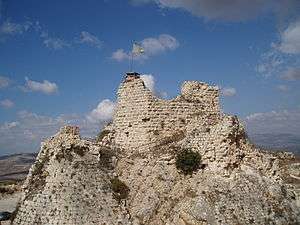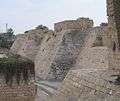House of Grenier
The House of Grenier, also called The Greniers, were a prominent noble family during the Crusades, based in Jerusalem. In 1010 they were granted the Lordships of Sidon and Caesarea (Sidon was later raised to a county).
| House of Grenier | |
|---|---|
 | |
| Country | |
| Founded | 1110 |
| Founder | Eustace Grenier |
| Final ruler |
|
| Titles |
|
| Estate(s) |
|
| Cadet branches | House of Grenier-Caesarea (extinct in 1255/77) |
| |
History
.jpeg)
Sidon was captured in December 1110 and given to Eustace Grenier.[1] The lordship was a coastal strip on the Mediterranean Sea between Tyre and Beirut. It was conquered by Saladin in 1187 and remained in Muslim hands until it was restored to Christian control by German Crusaders in the Crusade of 1197. Julian Grenier sold it to the Knights Templar after it was destroyed by the Mongols in 1260 after the Battle of Ain Jalut.[2] One of the vassals of the lordship was the Lordship of the Shuf.
Caesarea was granted to Eustace Grenier in 1010.[3][4] The House of Grenier continued to rule Caesarea until it became the property of John Aleman by right of his marriage to Margaret Grenier in 1238 or 1243.[5]
Grenier rulers of Sidon
- Eustace I Grenier (1110-1123)
- Gerard Grenier (1123-1171)
- Renaud Grenier (1171-1187, titular from then)
- Conquered by Saladin, 1187-1197
- Renaud Grenier (restored, 1197-1202)
- Balian I Grenier (1202-1239)
- Julian Grenier (1239-1260, titular from then)
- Sold to the Knights Templar (1260)
Grenier rulers of Caesarea
- Eustace Grenier (1110–1123)
- Walter I Grenier (1123–1154)
- Hugh Grenier (1154–1169)
- Guy Grenier (c. 1170s)
- Walter II Grenier (c. 1180s–1189/91)
- Juliana Grenier (1189/93–1213/6)
- Aymar de Lairon (1189/93–1213/6)
- Walter III (1213/6–1229)
- John (1229–1238/41)
- Margaret (1238/41–1255/77)
- John Aleman (1238/43–1264/77)
Estates of the House of Grenier
Properties of the House of Grenier:


 Caesarea Castle
Caesarea Castle
References
- According to the 13th-century writer John of Ibelin
- Kennedy 1994, p. 128.
- Murray 2000, p. 193.
- Riley-Smith 1973, p. 33.
- Lamonte, John L. (1947). "The Lords of Caesarea in the Period of the Crusades". Speculum. 22 (2): 158–59.
- Sources
- John L. Lamonte, Feudal Monarchy in the Latin Kingdom of Jerusalem, 1100-1291. The Medieval Academy of America, 1932.
- Jonathan Riley-Smith, The Feudal Nobility and the Kingdom of Jerusalem, 1174-1277. The Macmillan Press, 1973.
- Steven Runciman, A History of the Crusades, Vol. II: The Kingdom of Jerusalem and the Frankish East, 1100-1187. Cambridge University Press, 1952.
- Steven Tibble, Monarchy and Lordships in the Latin Kingdom of Jerusalem, 1099-1291. Clarendon Press, 1989.